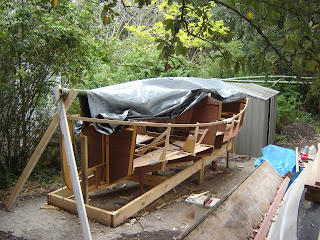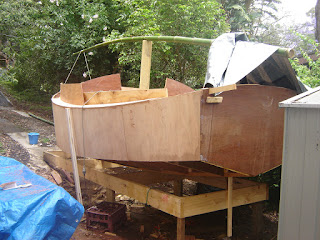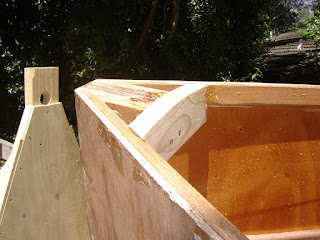Boats - The Magic Puddin'.
My local sailing club is promoted as being for 'drinkers with a boating problem'. Well, I am not much of a drinker but the rest might be appropriate.
In 2006 I built a boat and called it 'the Magic Puddin'. The magic puddin' is a character in and Australian children's' story by Norman Lindsay, who was an artist and painter. (https://en.wikipedia.org/wiki/Norman_Lindsay). The Magic Puddin' could be eaten, tasting like anything you wanted, and after it would regenerate creating an endless source of food for the owner.
I had enjoyed a number of years of twilight racing in an old star class boat that had been given to me. I like to sail on my own. That way I am not dependant on a crew turning up and besides, I find sailing quite meditative. When I moved away from the area I was unable to keep the Star so for a time I was without a boat.
I have always liked the look and the idea of a catboat, particularly those of Cape Cod as you see them in old Wooden Boat magazines and the like. I decided to build a catboat. One sail to handle would make life easy. There were other criteria to meet. The boat would be trailered, meaning it had to be light. I liked the idea of being able to spend a night on board from time to time, so the boat had to have a cabin and a decent bunk. Sleepless nights playing with the requirements and the possibilities followed and finally I was ready to draw some lines.
One morning I took a clean sheet of plywood out onto the back deck of the house and set myself up for drawing. I had some drawing weights and splines and an idea of basic dimensions. Although I am totally a metric minded person in a metric country I will use imperial measurements here. The maximum trailerable width in Austalia is 8ft. I decide to play safe and make the boat 7'6" wide. I could get a reasonable length to breadth ratio if I made the boat 18ft long. And so it went applying the various criteria and literally joining the dots with lines that looked like a boat that would please my eye. The boat would be plywood and a single chine section would be easy to build and stable.
In 2006 I built a boat and called it 'the Magic Puddin'. The magic puddin' is a character in and Australian children's' story by Norman Lindsay, who was an artist and painter. (https://en.wikipedia.org/wiki/Norman_Lindsay). The Magic Puddin' could be eaten, tasting like anything you wanted, and after it would regenerate creating an endless source of food for the owner.
I had enjoyed a number of years of twilight racing in an old star class boat that had been given to me. I like to sail on my own. That way I am not dependant on a crew turning up and besides, I find sailing quite meditative. When I moved away from the area I was unable to keep the Star so for a time I was without a boat.
I have always liked the look and the idea of a catboat, particularly those of Cape Cod as you see them in old Wooden Boat magazines and the like. I decided to build a catboat. One sail to handle would make life easy. There were other criteria to meet. The boat would be trailered, meaning it had to be light. I liked the idea of being able to spend a night on board from time to time, so the boat had to have a cabin and a decent bunk. Sleepless nights playing with the requirements and the possibilities followed and finally I was ready to draw some lines.
One morning I took a clean sheet of plywood out onto the back deck of the house and set myself up for drawing. I had some drawing weights and splines and an idea of basic dimensions. Although I am totally a metric minded person in a metric country I will use imperial measurements here. The maximum trailerable width in Austalia is 8ft. I decide to play safe and make the boat 7'6" wide. I could get a reasonable length to breadth ratio if I made the boat 18ft long. And so it went applying the various criteria and literally joining the dots with lines that looked like a boat that would please my eye. The boat would be plywood and a single chine section would be easy to build and stable.
The lines here a not the original lines but a later iteration.
I had recently built an extension on our house and I had some plywood sheets left over. These were mostly 3/16" bracing plywood and 1/2" exterior grade pine plywood. The bracing plywood was hardwood. I made the bulkheads and transom from the bracing plywood and framed them with el cheapo dressed pine from the local timber yard. My only expensive item was epoxy. Lots of it.
I had to build the boat outdoors in the driveway. I used a tarpaulin but I still had problems with everything getting wet occasionally.
The side panels were 3/8 Okume marine ply
I made stands for the ends so I could put the boat on a rotisserie.
Here it is on the rotisserie. The metal brackets temporarily bolted to the ends of the boat.
The bottom panels of 1/2 CD ply which was too hard to bend and twist at the bow so I laminated some of the thinner plywood into shape.
The bottom was epoxy sheathed with 8 oz fibreglass woven cloth.
At this point, my photographic collection is a bit sparse. After the bottom was sheathed and painted I finished the cabin and cockpit. More about that soon. I put the boat on a trailer and parked it out on the street.
The boat is built with two water ballast tanks, one each side of the centreboard case which is long enough to hold a pivoting centreboard. The centreboard I used was from a 16ft skiff and was about 5ft long and made from glass-sheathed wood about an inch thick. Each ballast tank held about 22 imperial gallons of water. (100 litres) . The water could be pumped in or out of the tanks using standard bilge pumps. Even with all the ballast and a wide hull, the boat was quite tender but also quite lively. Often in our twilight racing, we would run before the wind on the last leg to the finish line and I would flick the switch to empty the tanks as I rounded the last mark. I would cross the finish line 440 pounds lighter than I started.
I was very keen to see the boat in the water and check for leaks so in it went without rigging, fittings or ballast.
I thought it looked rather nice.
After some time I sourced a long piece of aluminium tube for a mast and used a collection of old boat bits to make up a gaff rig. I had the old Star mainsail and I cut it down and hand stitched it to fit the gaff. At last, it was ready for a trial. I didn't have the pumps ready for the ballast tanks so I put some bags of sand in the bottom of the boat. Trailering I tied the obligatory white plastic bag to the end of the mast and somehow forgot to remove it before launching.
The trial was a success even without a boom vang. I also had the ballast a bit too far forward.
Of course, when you go sailing on your own you don't get a lot of photos of the boat. Here are a few taken at the end of a race.
You might notice here that there is a trailer winch on the bowsprit. This is how I raised and lowered the mast.
After a few seasons of sailing and living on the trailer under the trees the boat was in pretty bad shape and needed some work.
I had always thought the boat might go a bit better with a flatter run aft so I modified the last 3 feet of the boat and altered the transom. In fact, I cut the transom down and changed the outboard motor arrangement. I also found some better sails and added a jib and later a longer bowsprit and a kind of reaching staysail. I made a new gaff from a windsurfer mast.
We moved house again and I had nowhere to put the boat so I took it up to our cottage in the mountains and put a cover on it and forgot about it for a while. By the time I got back to it the boat was in pretty bad shape. My wife and I had an inspiration to take the boat on long river trip. We weren't going to sail and I thought a drastic makeover might be fun. I drew some lines that made it look like a little tug boat or ferry and I bought a bigger second hand four stroke outboard motor.
I brought the boat back to our house, put it in the driveway and proceded to do something that attracted a lot of attention.
And so we put our strange little boat in the water and had quite a nice time with it.
Sometime later disaster struck.
Where I had removed the old centreboard case a leak had developed. It wasn't a problem as I had plenty of battery power and an automatic new bilge pump. One winter morning I walked down to check the boat which was now living on a mooring. It looked low in the water. The weather was foul and by the time I had gone home to get my dingy and returned to check the boat it was sinking. I called a friend with a power boat and he managed to pull the boat to shore. Everything was ruined. The boat being in salt water all the electrical gear and the cushions were damaged beyond repair. The motor was retrievable so I removed it and cleaned it up and got it going again. It turns out the bilge pumps float switch had not activated. I tested it and although it still worked, on the odd accasion it would not switch. I guess the moral of the story is don't buy a cheap bilge pump.
In my disgust with the whole affair I removed all the superstructure, put the boat back on the mooring with a small half cabin and ignored it for some time. Eventually I sold the boat to someone with more energy than I could muster.






















































Comments
Post a Comment